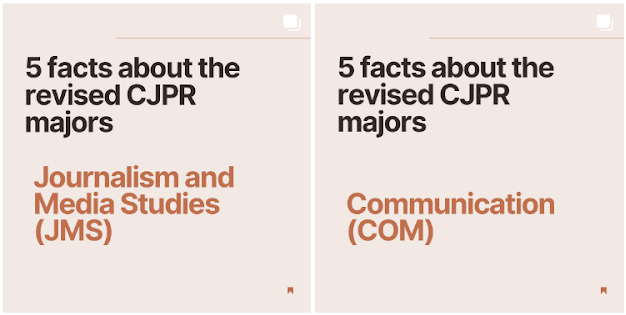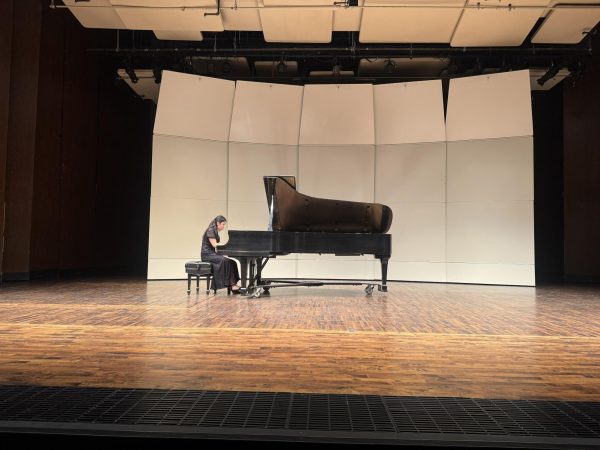New journalism and media studies major, specializations announced
Just before class registration opened on March 20, the Department of Communication, Journalism and Public Relations announced revised majors and new specializations for Journalism and Communication programs.
The new programs are:
- Journalism and Media Studies, B.A., Specialization in Media and Society
- Journalism and Media Studies, B.A., Specialization in Journalism
- Journalism and Media Studies, B.A., Specialization in Broadcasting and Digital Media Practice
- Revised Communication, B.A.
The most notable change is that all courses previously identified as JRN or COM will become JMS courses as of Fall 2023. Classes previously named with the outgoing labels will retain the same course numbers (i.e., JRN 2000 is now JMS 2000, and COM 3607 is now JMS 3607).
Communication professor and CJPR department chair Kathleen Battles worked on the new JMS program alongside other faculty members. She highlighted the most significant updates:
For Journalism and Media Studies (JMS):
- “Media Studies and Media Production courses have been moved out of the Communication program and into the Journalism program, now an expanded Journalism and Media Studies program (JMS),” Battles said.
- “JMS requires students to specialize. Still, all JMS students will take a core group of courses to provide shared theoretical and practical knowledge for understanding and working in media-related jobs.
- “Broadcasting and Digital Media Practice specialization: Broadcasting or digital media production in a more general perspective.
- “Media and Society Specialization: Media understanding, but not focused on the production,” she said.
“(…) Even within those specializations, there’s more depth, given that blending of theory, concepts and practice,” said Holly Gilbert, instructor of practice and chief academic adviser for Journalism and PR courses.
For Communication (COM):
- “The newly revised program offers students more flexibility through more elective credits,” Battles said.
- “There is still a required core of courses, but students will now only have to take classes in two different course groups.
- “The class categories have been reorganized so that students can better see the kinds of courses that match their career goals — new groups are Relational Communication, Organizational Communication, Advocacy and Social Influence, Culture and Communication and Practicum,” Battles said.
- “COM 3300 (which used to be Multicultural Communication) is now Communication, Culture and Belonging,” she said. “Students who have already taken 3300 do not need to retake it.”
“The COM changes similarly reflect the ways that our field has changed: New questions get asked, and new areas of study open up,” Communication Professor Tom Discenna said. “The exciting thing is the way this continuously evolved.”
Internships:
- “The department will now have only one Internship course,” Battles said. “Students in JMS, PR and COM who need to do an Internship for their capstone will now all register for the Communication Internship course.”
“As a faculty member in COM, I can tell you that we are very excited about the changes coming to the department,” Communication Professor Jennifer Heisler said. “This combination of media and journalism is much more relevant to the types of writing, working and media our students are seeing after graduation.”
Behind the scenes, the motivations behind the program updates vary from keeping up with the industry to making the programs more attractive to students, since enrollment has decreased by almost half compared to previous years.
“Curriculum changes are a regular feature of academic work. As we learn new things about what we study, we make changes to the way we teach,” Discenna said. “Most of the time, these changes are incremental.”
To faculty, the new organization of both Communication and Journalism and Media Studies will emphasize to students the connections between their degree and their possible future careers.
“Our department had long struggled with where to put their production courses, and JMS gives them a clear home,” Battles said. “The creation of the Journalism and Media Studies specializations gives students many more opportunities to find their passions.”
All current students can continue following the previous COM or JRN requirements they started using. However, if they decide to switch to the revised programs, the faculty affirms it will not be a complicated process.
“Since it is a revision of the existing major, existing JRN or COM students are likely to find it pretty easy to switch to JMS,” said Erin Meyers, a CJPR media studies professor who led this initiative. “If you’ve already been taking courses in the media area of COM or in JRN, these will count towards the JMS major.”
Faculty believes switching to new majors is a good idea in specific circumstances.
“Current students would want to switch to better focus their studies on the path that interests them most,” Meyers said, “and they’ll be able to show potential future employers that they have this particular specialization that prepares them for a range of different career paths.”
While Communication and Journalism programs have a new face, the Public Relations program stays the same. PR majors can take JMS courses as electives, just as they could before.
“In another way, this opens up new possibilities for PR students interested in double majoring,” Battles said. “Overall, there are many more pathways that one can find in the department that builds a set of courses that aligns with their interests and goals.”
Students can now mix and match JMS and PR majors and minors uniquely.
“As predicted at the outset, the PR major is still very attractive to our students,” Heisler said. “Many of our earlier graduates from years ago in COM or JRN find themselves working in PR environments. Plus, you know our PRSSA organization is, I’d say, the best in Michigan.”
As for classes, content is always updated to keep up with the field and the media industry.
“Course content is continuously changing, so this is not just ‘old wine in new bottles,'” Discenna said.
But credits won’t be counted any differently, and the core of the curriculum is still the same.
“The great thing about these changes is that we are still us,” Battles said. “Some classes might change their content a bit, but overall, the courses themselves will be the same, and of course, the faculty will be the same.”
While students get used to the revised programs, faculty already have their favorite aspects of it.
“The pairing of media studies with journalism makes so much sense, and the packaging provides so many advantages to students,” Gilbert said. “But no matter what they pursue, they’re going to be able to explore their interests through a wider lens.”
“My favorite thing is how the JMS major offers a mix of theory-based and practice-based courses,” Meyers said. “All of the specializations offer this, but let students go down the path that interests them more.”
“My favorite thing about these changes is that it really helps to clarify the different areas that we study in COM — […] it reflects on the way the field has moved since we last developed the categories,” Discenna said.
For Battles, it’s all about offering new paths.
“I am also excited because we receive many inquiries regarding the possibility of majoring in broadcasting and media but have never been able to offer that to students — now we can,” Battles said. “These changes make our majors make more sense, both to ourselves and to our students. I think students will enjoy the ability to tailor their coursework to their own interests.”
Battles pointed out that the new changes play on the existing strengths of CJPR faculty and will allow new ways to engage with students.
“I think CJPR students will find that the overall experience of life in the department — our small classes, active student orgs, quality curriculum and overall blend of theory and practice that is the hallmark of our department — unchanged,” Battles said. “If anything, these changes will help create some new energy in our department as students find new ways to experience our majors.”
If you are interested in the new programs and specializations or want to understand better what the changes look like, the CJPR department has a folder with materials available.
Students interested in switching are encouraged to talk to either the JMS advisor, Holly Gilbert, or the COM Advisor, Tom Discenna. Students are also encouraged to speak to one of the department advisers.





